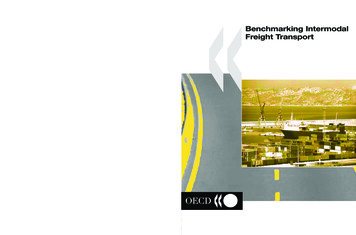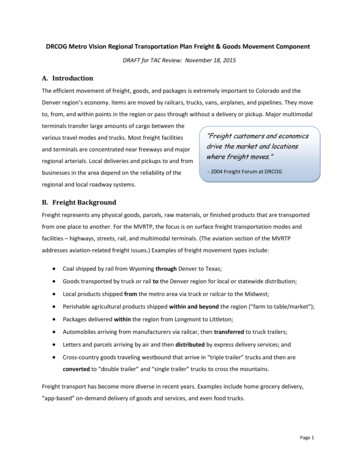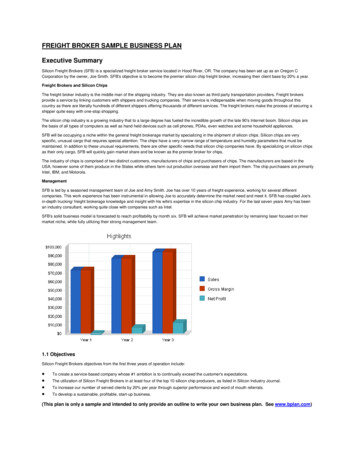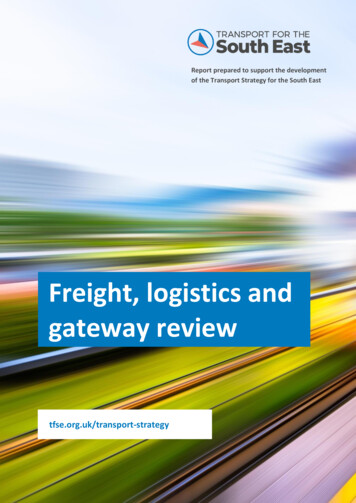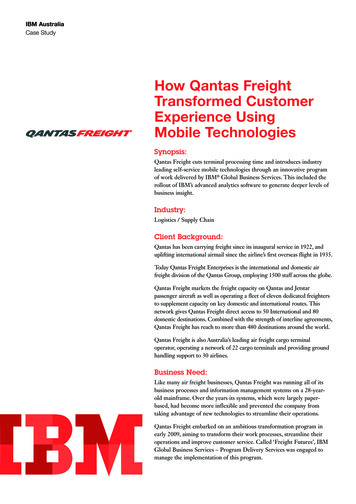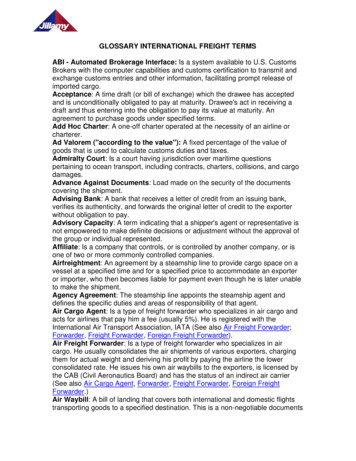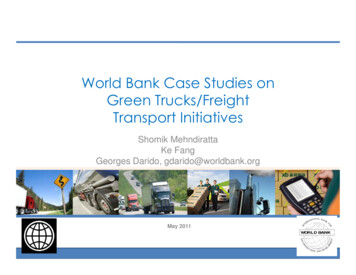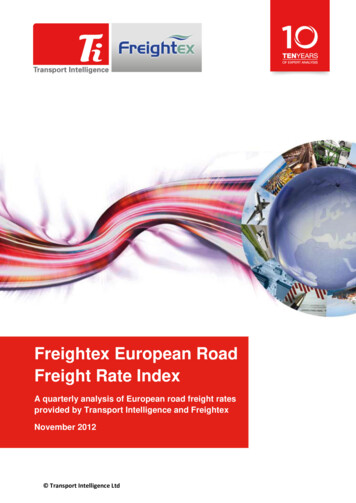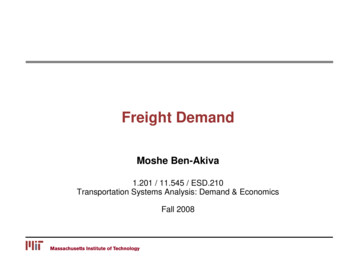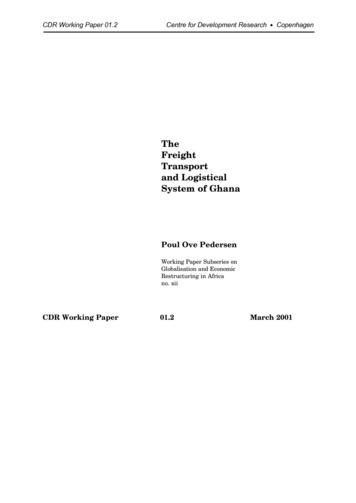
Transcription
CDR Working Paper 01.2Centre for Development Research CopenhagenTheFreightTransportand LogisticalSystem of GhanaPoul Ove PedersenWorking Paper Subseries onGlobalisation and EconomicRestructuring in Africano. xiiCDR Working Paper01.2March 2001
CDR Working Paper 01.2 Centre for Development Research CopenhagenThe author and Centre for Development Research, 2001Published and distributed by Centre for Development ResearchPrinted in Denmark by Centre for Development ResearchISSN 0904-4701ISSN 1399-3402Keywords:FreightRoad transportSea transportTransportTransport infrastructureGhanaThe Working Paper Subseries on Globalisation and Economic Restructuring in Africa are publishedwithin the framework of CDR Working Papers (green series). The papers are draft works produced aspart of the research programme under this title, based jointly at the Centre for DevelopmentResearch and the Institute of Geography, Copenhagen University. The programme started in 1998.From 1999 the programme will enjoy support from the Danish Social Science Research Council andthe Danish Council for Development Research. It studies local, national and international dimensionsof current changes in a series of global commodity chains emanating, in part at least, from Africa.For further information on the programme, please contact Peter Gibbon (e-mail address pgi@cdr.dk).CDR Working Paper Subseries are available on an exchange basis and individual titles are suppliedfree of charge.
kmB U R K I N A10050F A S OBawkuCapitalNavrongoTumuCityTownBolgatangaSmall townLawraWuluguNadawliMain roads:more trafficless trafficRailwayWaFerryRiverite Volt aWhBoundaryTamaleYendiSawlaBoleBimbilaBuipeT O G Oack VoltBlaI V O R YC O A S riTechimanL A K EV O L T iBibianiAwasoObuasiDunkwaOdaFosoPresteaA T L A N T I CVo ltaAchiasiJunctionKotokuJunctionWinnebaCape CoastSekondiO C E A NketaTemaAccraTarkwaTakoradiShaiHillsNsawamHuni ValleyKojokromAximKoforidua AkosomboKadeG U L F O FG U I N E AGHANA
CDR Working Paper 01.2Centre for Development Research CopenhagenAbstractThe paper gives detailed account of the historical development of the transport system inGhana with special emphasis on the last decades, and from a logistical point of view. Whilemost of the African transport research has tended to focus on the transport infrastructure thefocus here is more on the transport services and the enterprises in the transport sector whichprovide these services.In the developed world the logictical revolution has during the last three decades hadimportant consequences for both the transport system itself and for development at large. Ithas led to increased integration between the different transport modes in the door-to-doortransport chains, through containerization (or unitarisation) and the developmentof large often very expensive multi-mode transport terminals; increased integration or coordination between transport and production; and a spatial reorganisation of both production and transport networks into hub-andspoke systems centred on few and larger centres.However, in Africa these processes have in general not proceeded very far and thepaper investigates to which extent they have taken place in Ghana.1. The logistical revolution and the development of freighttransportation in Africa - an introductionThe purpose of this paper is to look at the development of the transport system of Ghana from alogistical viewpoint. Historically Ghana is an interesting case because Taaffe, Morrill and Gould’s(1963) study of Ghana’s transport system made it the prototype of how the transport systemsdeveloped by the colonial powers have structured the economy of African countries and led tounderdevelopment.As most of the literature before 1970 Taaffe, Morrill and Gould perceived transport costs fromresources or to markets as one of the most important explanatory variables in economic geographyand the economics of location. However, in the early 1970s this perception of the importance oftransportation changed rather suddenly as a result of the increasing internationalisation of production.Through subcontracting and outsourcing the old factory production was now seen to be split up andproduction as a whole or in part relocated to other parts of the globe in search of lower production1
CDR Working Paper 01.2Centre for Development Research Copenhagencosts, primarily cheap labour. In the process transportation costs dropped out of the theories ofindustrial location, presumably because they now had become so low that they no longer were seenas important. As a result most studies of the internationalisation or globalization of production do noteven consider the role of transportation, though transaction and communication costs since the mid1980s have been seen to play an increasingly important role. From playing a central role inmainstream economic geography, transport geography was reduced to a niche specialisation withoutdirect link to mainstream economic geography.However, there are a number of reasons why the disappearance of transportation from economicgeography is problematic. First, although it is true that the average per unit transport costs havedecreased dramatically, the role of transport in the national accounts have generally not decreased,because the cheaper unit transport has become the more goods have been moved over still longerdistances. In the accounts of individual producers this may not be visible because an increasing shareof the transport costs are hidden in the payments to subcontractors.Another reason why the negligence of transportation costs is problematic is that the reduction intransport costs has not been uniform for all commodity flows. Transport costs have generally beenreduced most where large amounts of goods are moved, and it has increasingly depended on thedevelopment of improved infrastructure. Therefore many of the least developed countries andespecially many countries in Africa have not benefitted proportionally from the reduced transportcosts. This handicap is further pronounced because many of the transaction, corruption and rentseeking costs recognised by the transaction cost theory are linked to real or artificial bottlenecks inthe transport and communication systems.Most importantly, however, the role of transportation in production has changed since the 1970s,when transportation costs were dropped from the location theories. From being an activity externalto the production transportation has increasingly become an integrated part of the productionprocess. Partly as a result of new production technologies, such as just-in-time, external transportcosts have increasingly become substitutable with costs of internal transportation and storage. Thishas led to the so-called logistical revolution, as a result of which enterprises no longer minimise theirtransport costs, but rather their much larger logistical costs, consisting of the external transport costas well as the costs of internal transportation and storage. At the same time, travel time has oftenbecome equally or even more important that economic cost.For the study of transportation the logistical revolution has had two important consequences: Firstly, the focus has shifted away from the individual modes of transportation (port-toport) to integrated multi-modal transport (door-to-door) and led to processes of vertical2
CDR Working Paper 01.2Centre for Development Research Copenhagenintegration in the transport sector similar to those described for production sectors incommodity chain analysis. This development was spearheaded by the developmentsince the 1970s of large multinational forwarding companies which have beencoordinating and controlling an increasing share of the international commodity flows,often without their own means of transport. However, during the 1990s the largeshipping and airline companies have increasingly attempted to take over thesecoordinating and information controlling activities which have proved to be veryprofitable. Secondly, transport has, as other parts of the production process, become subject tostrategic decisions about integration or outsourcing. These decisions to a large extentdepends on the processes of restructuring and vertical integration taking place in thedominating commodity chains served by the transport system. They also depend on theavailability or non-availability of publicly financed infrastructure and explains the paradoxthat enterprises often lobby heavily for improved transport infrastructure at the sametime as development theory claims that transport costs are not important. Thirdly, efficient transportation has become increasingly capital intensive and dependenton expensive infrastructures and transport terminals which only large transport flows willbe able to pay for. Therefore the traffic has tended to be concentrated on fewer andlarger transport terminals. This has tended to result in a spatial reorganisation ofproduction and a new regionalisation of the economy focused on fewer and largercentres.These trends towards vertical integration or coordination within the transport system itself, horizontalintegration or interdependency with the transport users, and a new regionalisation, which during the1980s and 1990s have become increasingly important in the industrialised and industrialisingcountries, have, as we shall show below, been much slower to develop in Africa and otherdeveloping parts of the world.They have also had surprisingly little impact on the literature on transport and development in Africa.Thus the two most recent textbooks on transport and development (Hilling 1996; Simon 1996) havelittle to say about the logistical revolution and forwarding companies. One important reason for thisprobably is that most of the transport research done in Africa has been done in connection with largeWorld Bank or donor investment projects.The purpose of this paper is to look at the development of the transport system of Ghana from sucha more logistical point of view. In order to do this we shall study all the modes of freight transport3
CDR Working Paper 01.2Centre for Development Research Copenhagenand the (often missing or rudimentary) links between them, and we shall focus on the transportoperators and organisers rather than on the infrastructure, although we will of course to some extentalso have to discuss the development of infrastructure.Although it would be logical from a logistical viewpoint to study the transport system in a more globalor at least regional perspective, the paper focuses for practical reasons rather narrowly on Ghanaand its trade, with few references and comparisons to other areas. However the paper is part of alarger project which shall also look in detail at the transport systems in other parts of Africa, andPedersen (2001) attempts more broadly to look on Africa’s position in the world’s transport system.In Section 2 of this paper we describe, as an introduction, the historical development of transportinfrastructure in Ghana. The information presented on the development during the colonial era ismostly based on Gould’s study from 1960. Sections 3-6 analyse different parts of the transportsystem since independence, with emphasis on the transport operators rather than on theinfrastructure. These sections are based partly on a number of consultancy reports and partly on 42interviews with firms and public administrations in the transport sector carried out during one monthof field work during January/February 2000. In Section 3 we analyse the development of the portsand the shipping industry since independence with emphasis on the increasing containerisation.Section 4 discusses the inland transport corridors from the ports: Lake Volta inland shipping, therailways and the road transit traffic to Burkina Faso and Niger. Section 5 looks at the developmentof the trucking industry, and Section 6 at the rural transport and the development of intermediatemodes of transport. Section 7 looks at the air freight. Finally Section 8 attempts to see thedevelopment in Ghana’s transport system since independence in the light of a logistical chain analysis,focusing on the full logistical chain and the interaction between production, distribution and transport.2. The development of transport infrastructure in GhanaBefore 1900: the pre -colonial eraIn 1960 just after Ghana’s independence, Gould (1960) published a detailed study of thedevelopment of transportation in Ghana. This study together with a similar study of Nigeria’stransport system became one of the building blocks in Taaffe, Morrill and Gould’s (1963) seminalpaper which presented a step model of transport expansion in developing countries, which during the1970s and 1980s came to be seen as the prototype of transport development under colonial rule andresource exploitation.4
CDR Working Paper 01.2Centre for Development Research CopenhagenIn the first phase of their model a large number of small ports and landing points are established alongthe coast. During the next phase a process of selection takes place, where some of the ports looseout and others win depending on the ease of access to resources in the hinterland and increasingly onthe investments in roads and railroads linking the ports with their hinterlands. During the third phasefeeder roads are built to the main transport lines, and increasing differentiation among the ports takesplace. In the fourth phase the major centres along the transport links to different ports are connected.At the same time the centres along the main transport lines are increasingly differentiated. During thefifth phase all the main inland centres are interconnected, and finally during the sixth phase new highpriority links are developed within the interconnected network.During the 1970s and 1980s one of the criticisms of colonial development was that the last phases oftransport development never took place because the purpose of colonial development was resourceexploitation and export rather than local development.In Ghana the development of the colonial transport system started during the 16th, 17th and 18thcentury with the establishment of some 40 small surf ports or landing points along the coast of Ghana(often located together with a fort) first by Portuguese and later by British, Dutch, Danish and otherEuropean trading companies, trading primarily in slaves and gold and to a smaller extent also in ivory.There was a considerable competition and increasing differentiation between the ports, and duringthe 19th century and especially after the British in 1869 took over the Dutch forts and became thesole coloniser, the trade increasingly concentrated on still fewer ports, so that in 1900 only 6 portsaccounted for 81% of all the export trade and 75% of all the import (Gould 1960). Cape Coast,which was the starting point for the most important trails to Kumasi, was the most important of theports, but Ada, at the mouth of river Volta, and Accra were also important. Accra especially grewafter the British moved their headquarters from Cape Coast to Accra in 1877. This process of portconsolidation, which Dickson (1965) and Hilling (1977) have described in detail culminated with thebuilding of the railroads from Secondi to Kumasi (1901-04) and from Accra to Kumasi (1915-23)and later the two modern ports in Takoradi (1928) and Tema (1962).After abolishment of the slave trade during the first decades of the 19th century (the Danes abolishedit officially in 1804, the British in 1807) trade in agricultural produce gradually increased, primarilypalm oil and rubber, but also timber from western Ghana and maize and cattle (not for Europe butfor the other forts along the coast), and small amounts of coffee and cotton from eastern Ghana andespecially the area around Accra. After 1891 cocoa rapidly became important.While the inland trade in and transport of slaves and gold before the 19th century largely wascontrolled by the African coastal tribes or the Ashanti, the expansion of agricultural production forexport required increased presence of European producers and traders. This together with the5
CDR Working Paper 01.2Centre for Development Research Copenhagenprohibition of the slave trade, which had been very profitable for the Ashanti, led to a series ofAshanti wars, which slowed the development of agricultural production for export, and only stoppedwhen the Ashanti were forced to surrender in 1896 and Ghana in 1901 became a British CrownColony. The coastal states already became a British Crown Colony in 1874. However, probablymore important for the relative slow development of an export production was the lack of inlandtransport which tended to limit production of heavy products to areas in close proximity of the exportharbours.Before 1874 most inland transport was based on head carriage on narrow trails often not wellmaintained, though transport with river canoes was possible in some areas. In 1874 when the Britishmade the coastal states a crown colony, ”.two developments took place. . First, villagesalong the main trade routes were encouraged to keep them open and cleared to speed the flow oftrade, and secondly, an administrative network of hammock tracks was cleared to enable officers toget around their districts. . The result was that by 1890 the old north-south alignment had beenstrengthened by a few well-cleared tracks, while a subsidiary network of trails had been clearedbetween administrative centres and more important villages. . the improvements themselves,together with the peaceful conditions that followed the 1873 expeditions against the Ashanti, soencouraged the trade, particularly in bulk commodities such as palm oil, that transportationimprovements could no longer be left entirely in local hands. In .1890 an inspector of trade roadswas appointed, and. In 1894 a roads department was set up which immediately started aprogrammeto build and maintain roads in the colony .” (Gould 1960, p. 13).Before 1900 the road from Cape Coast to Kumasi, which had been improved during the 1873campaign against the Ashanti, was rebuilt and extended north worth to Kintampo and Mapong.Roads were built inland from Accra to the Accra plain and the Akim Goldfields. Roads were built toby-pass the rapids on river Volta. A road was built from the goldmine in Tarkwa to Ankobra river;and roads were built from Saltpond and other ports into the palm oil producing areas, along whichpalm oil barrels now were rolled down to the ports.At 1900 the pattern of transport flows consisted of fairly short haul export flows of palm oil and palmkernels from the forest belt close to the coast, of somewhat longer flows of rubber from Kumasi andcocoa from the hinterland of Accra, of long haul northbound flows of kola nuts from Kumasi intoNorthern Sahel, of salt especially along Volta river, but also via Kumasi, and of cloths and othertrade goods via Kumasi, but in heavy competition with goods coming in from Togoland and Coted’Ivoire (in both countries the first railroads were opened in 1907).6
CDR Working Paper 01.2Centre for Development Research Copenhagen1900-1920: the railway eraHowever, the big transport revolution came when the first railway was built from Secondi, first to thegoldmine in Tarkwa (1901) and then further on to Obuasi (1903) and Kumasi (1904). In 1907 abranch line from Tarkwa was opened into the goldmining areas. Also in 1907 the first stretch of arailway line from Accra into the cocoa producing areas was opened, and extended several times toreach Korforidua in 1915 and Tafo in 1918, where it stopped due to wartime shortages.The western line from the beginning carried machinery and building materials to the gold mines, coalto the mines and the railway itself, and local agricultural produce to feed the growing number ofmining workers. Later increasing amounts of cocoa were exported from the area around Kumasi,while agricultural produce was brought to the growing town of Kumasi. The eastern line primarilybrought the rapidly expanding cocoa production down to Accra for export and agricultural producefor the provision of the town while much less was transported the other way. In 1915 the Secondiline was three time as large as the Accra line in terms of total tonnage transported, but while 41,000tons of cocoa were shipped to Accra, only 19,000 tons were shipped to Secondi.As Gould writes: “In the period 1900-1919 . railway development was a response to twotypes of economic incentives which were often complementary. One was the need to join areas ofpotential agricultural and mineral production to an outlet on the world trade routes to take advantageof cheap movements of goods by ocean transportation. The other was the need to joinpotential markets, represented by Kumasi and its vast hinterland. . A second stage in the modelis the growth of internal trade as secondary areas of agricultural production . grow to supplythe mining areas and expanding urban centres. In the beginning these secondary areas tend to parallelthe railway lines and centre around the mining and urban areas themselves” (Gould 1960, p. 38).However, at the same time as the railways developed the road network continued to expand rapidly,but in a complementary way which supported the railway rather than competed with it. In areas withrailways it changed its original function as primary transportation facility and became a feeder to therailway creating access for commodities from areas previously inaccessible to the railway and thusbolstering the main traffic streams.During the 1900-1919 period three types of road development took place:- Feeder roads were built to the railway stations and especially to the railhead in Kumasi expandingthe hinterland of the railway, but not roads which could have competed with the railways. Thus therewas a definite policy not to close the gab in the road between Kumasi and the coast (it was notcompleted until 1958) and the road between Accra and Kumasi was not improved.7
CDR Working Paper 01.2Centre for Development Research Copenhagen- Roads from the larger port were extended further into the palm oil belt which increased the exportof palm oil, but also tended to cut off the smaller ports from their hinterland and led to theconcentration of the trade on fewer ports. Between 1900 and 1924, the number of ports exportingcommodities fell from nineteen to nine, and the percentage of exports handled by the two leadingports (Cape Coast and Ada in 1900, Secondi and Accra in 1924), increased from 46% to 78%.- The roads from both Kumasi and Volta river into northern Ghana were built and a road network innorthern Ghana centred on Tamale was developed after Tamale had become the administrativecentre of Northern Ghana in 1907.By the end of the period the road network in Northern Ghanawas much better than in the south.1920-1940: competition between roads and railroads. The opening of Takoradi harbourAfter the First World War the railways expanded again with great optimism. Part of the western linewas realigned and the track weight increased from 45 lbs. to 80 lbs., the line between Accra andKumasi was opened in 1923, and a new line from Huni Valley on the western line into CentralProvince was opened to Kade in 1927. The improvements of the western line speeded up the exportof manganese which had started in 1916 during the war, but it also carried increasing amounts ofcocoa. The eastern and central lines were very dependent on cocoa.The opening of the modern harbour in Takoradi in 1928 reduced the loading and turnaround timesdramatically. According to Gould (1960, p.56) the loading time of manganese ships went down fromthree weeks to three days.However, at the same time the network of both feeder and trunk roads was expanding, and from themid-1920s the main roads were increasingly tarmacked which cut in half the cost of hauling by lorryon these roads. The feeder roads were responsible for the rapid expansion of the cocoa belt, and thenew trunk roads made it possible for the lorries to conquer an increasing share of the long distancecocoa transport in the Eastern and Central Provinces. In Central Province much of the cocoa wasnot carried by the railways to Secondi/Takoradi or Accra, but shipped on the improved roads to thesmaller ports in Cape Coast, Saltpond and Winneba, which experienced a short revival during the1920s. However, as a result of improved roads into British Togoland Accra conquered parts of thegrowing cocoa production there which earlier went on the railway to Lomé in French Togo. On theother hand the growing amount of cocoa produced in Ashanti was forced on the railway because ofthe policy not to improve the roads from Kumasi to Accra and Takoradi. Thus an up-to-date roadbetween Kumasi and Accra was not build until the late 1930s and the last gap in the road betweenKumasi and Takoradi even was not filled until 1958.8
CDR Working Paper 01.2Centre for Development Research CopenhagenThe success of the road transport was not just lower transport costs, but also that the expandinglorry transport had made it possible to reduce the cocoa season from seven to three months reducingdrying problems and the need for storage capacity, and in Central Province lorries were used even inareas where rail transport was clearly cheaper (Gould 1960, p. 68).In the Northern region the road network was further improved which resulted in increasedproduction of e.g. chicken, cattle and yams which were sold on the markets in Southern Ghana. Alsonew trunk roads into the French territories in Sahel were opened for motor traffic. This led to theopening of the first regular road service from Mopti to Kumasi via Ouagadougou carrying driedNiger perch and also other mainly agricultural goods from Naimey, other smaller towns along theNiger and the areas below the Niger arc. The old northbound caravan trade from Ashanti inkolanuts, which when the railways were built had converted into rail and ships transport via Secondi,Lagos and Kano, now reverted to the old overland route. Also the important salt trade from thesouth to the north which traditionally had been carried by canoes on river Volta was converted tolorries, with the result that the canoe traffic stopped.1940-1960: expansion of the road network. Opening of Tema harbourDuring the Second World War the railways regained its old strength first because the roadsteadports of Accra, Cape Coast, Saltpond and Winniba were closed to prevent attacks by submarines.This forced most of the cocoa to use the railways, but later when oil rationing almost closed the roadtraffic also agricultural produce for the national market was forced on to the railways. In addition railshipment of strategic materials such as manganese, and from 1941 of bauxite (between 1941 and1944 a new line was built to tap the deposits of bauxite in Awaso, but it soon also carried largeamounts of timber and cocoa), increased. At the same time the ship convoy system which had to beused during the war dumped huge loads all at one time at Takoradi. Rail traffic therefore had to besynchronized with the shipping movements to avoid congestion.In total freight traffic on the railways increased by 57% during the war, but without satisfying all thedemand. After the war the demand for transportation increased further as a result of both growingexports and the related boom in the internal economy and in imports. The westward move of cocoaproduction also increased the traffic pressure on the western line. To satisfy this increased demand,the carrying capacity was increased which, however, led to considerable capacity problems on theTarkwa-Takoradi section of the western rail line. Plans for doubling the line between the two townswere made in 1948, but only realised for the first thirty kilometres.As a result of the increasing pressure on the transport system in the postwar years plans weredeveloped around 1950 for the construction of a new port in Tema to serve Accra and the easternpart of the country. The port was part of a larger scheme of transport development and9
CDR Working Paper 01.2Centre for Development Research Copenhagenindustrialisation, including a large dam and power plant in Akosombo, a new waterway on the largeLake Volta created behind the dam and a number of large industries (e.g. an aluminum plant, a steelmill and an oil refinery) to exploit the new energy and infrastructure (see e.g. Hilling 1966). The portwas opened in 1962.As a response to the increasing pressure on the transport system about one third of the 1951Development Plan was allocated to railway and road transportation. For the railways the planallocated funds for new diesel locomotives and rolling stock, new terminal facilities in Takoradiharbour, and a number of new network extensions of which however only two were realised.First, in 1956 a link was opened between the central and eastern lines in order to provide aneconomic rail route for heavy import for Accra from Takoradi, which, however, became somewhatsuperfluous when the new port in Tema was opened in 1962.Secondly, in connection with the construction of the harbour in Tema a new railway link was alsobuilt from the eastern line to Tema, with a continuation to the granite quarries of the Shai Hills whichsupplied building materials to the harbour. The intension was that this line should have been continuedto the Volta River Dam as part of a new transport corridor along the large Volta Lake created by thebuilding of the dam. This extension, however, was never built and the line to Shai Hills closed whenthe harbour was constructed. The link from Tema was operated until one of the bridges on the linebroke down in 1993. So far it has not been re
1. The logistical revolution and the development of freight transportation in Africa - an introduction The purpose of this paper is to look at the development of the transport system of Ghana from a logistical viewpoint. Historically Ghana is an interesting case because Taaffe, Morrill and Gould's


